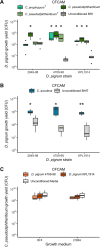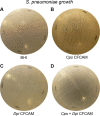Dolosigranulum pigrum Cooperation and Competition in Human Nasal Microbiota
- PMID: 32907957
- PMCID: PMC7485692
- DOI: 10.1128/mSphere.00852-20
Dolosigranulum pigrum Cooperation and Competition in Human Nasal Microbiota
Abstract
Multiple epidemiological studies identify Dolosigranulum pigrum as a candidate beneficial bacterium based on its positive association with health, including negative associations with nasal/nasopharyngeal colonization by the pathogenic species Staphylococcus aureus and Streptococcus pneumoniae Using a multipronged approach to gain new insights into D. pigrum function, we observed phenotypic interactions and predictions of genomic capacity that support the idea of a role for microbe-microbe interactions involving D. pigrum in shaping the composition of human nasal microbiota. We identified in vivo community-level and in vitro phenotypic cooperation by specific nasal Corynebacterium species. Also, D. pigrum inhibited S. aureus growth in vitro, whereas robust inhibition of S. pneumoniae required both D. pigrum and a nasal Corynebacterium together. D. pigrum l-lactic acid production was insufficient to account for these inhibitions. Genomic analysis of 11 strains revealed that D. pigrum has a small genome (average 1.86 Mb) and multiple predicted auxotrophies consistent with D. pigrum relying on its human host and on cocolonizing bacteria for key nutrients. Further, the accessory genome of D. pigrum harbored a diverse repertoire of biosynthetic gene clusters, some of which may have a role in microbe-microbe interactions. These new insights into D. pigrum's functions advance the field from compositional analysis to genomic and phenotypic experimentation on a potentially beneficial bacterial resident of the human upper respiratory tract and lay the foundation for future animal and clinical experiments.IMPORTANCEStaphylococcus aureus and Streptococcus pneumoniae infections cause significant morbidity and mortality in humans. For both, nasal colonization is a risk factor for infection. Studies of nasal microbiota identify Dolosigranulum pigrum as a benign bacterium present when adults are free of S. aureus or when children are free of S. pneumoniae Here, we validated these in vivo associations with functional assays. We found that D. pigrum inhibited S. aureusin vitro and, together with a specific nasal Corynebacterium species, also inhibited S. pneumoniae Furthermore, genomic analysis of D. pigrum indicated that it must obtain key nutrients from other nasal bacteria or from humans. These phenotypic interactions support the idea of a role for microbe-microbe interactions in shaping the composition of human nasal microbiota and implicate D. pigrum as a mutualist of humans. These findings support the feasibility of future development of microbe-targeted interventions to reshape nasal microbiota composition to exclude S. aureus and/or S. pneumoniae.
Keywords: Corynebacterium; Dolosigranulum pigrum; Staphylococcus aureus; Streptococcus pneumoniae; comparative genomics; interspecies interactions; microbe-microbe interactions; microbiota; nasal; upper respiratory tract.
Copyright © 2020 Brugger et al.
Figures





Similar articles
-
Synergistic inhibition of pneumococcal growth by Dolosigranulum pigrum and Corynebacterium pseudodiphtheriticum: insights into nasopharyngeal microbial interactions.Microbiol Spectr. 2025 Jul;13(7):e0013825. doi: 10.1128/spectrum.00138-25. Epub 2025 May 30. Microbiol Spectr. 2025. PMID: 40445193 Free PMC article.
-
Genomic Stability and Genetic Defense Systems in Dolosigranulum pigrum, a Candidate Beneficial Bacterium from the Human Microbiome.mSystems. 2021 Oct 26;6(5):e0042521. doi: 10.1128/mSystems.00425-21. Epub 2021 Sep 21. mSystems. 2021. PMID: 34546072 Free PMC article.
-
Towards the human nasal microbiome: Simulating D. pigrum and S. aureus.Front Cell Infect Microbiol. 2022 Oct 11;12:925215. doi: 10.3389/fcimb.2022.925215. eCollection 2022. Front Cell Infect Microbiol. 2022. PMID: 36605126 Free PMC article.
-
Interactions between bacteria in the human nasopharynx: a scoping review.Lancet Microbe. 2025 Jul;6(7):101062. doi: 10.1016/j.lanmic.2024.101062. Epub 2025 Mar 3. Lancet Microbe. 2025. PMID: 40049183
-
Staphylococcus aureus and Streptococcus pneumoniae interaction and response to pneumococcal vaccination: Myth or reality?Hum Vaccin Immunother. 2016;12(2):351-7. doi: 10.1080/21645515.2015.1081321. Hum Vaccin Immunother. 2016. PMID: 26905680 Free PMC article. Review.
Cited by
-
Regulatory mechanisms of sub-inhibitory levels antibiotics agent in bacterial virulence.Appl Microbiol Biotechnol. 2021 May;105(9):3495-3505. doi: 10.1007/s00253-021-11291-1. Epub 2021 Apr 24. Appl Microbiol Biotechnol. 2021. PMID: 33893838 Review.
-
Bacterial DNA screening to characterize surgical site infection risk in orthopaedic patients.J Orthop. 2021 Aug 25;27:56-62. doi: 10.1016/j.jor.2021.08.012. eCollection 2021 Sep-Oct. J Orthop. 2021. PMID: 34483551 Free PMC article.
-
Intranasal Application of Lactococcus lactis W136 Is Safe in Chronic Rhinosinusitis Patients With Previous Sinus Surgery.Front Cell Infect Microbiol. 2020 Oct 12;10:440. doi: 10.3389/fcimb.2020.00440. eCollection 2020. Front Cell Infect Microbiol. 2020. PMID: 33154953 Free PMC article.
-
Klebsiella pneumoniae peptide hijacks a Streptococcus pneumoniae permease to subvert pneumococcal growth and colonization.Commun Biol. 2024 Apr 8;7(1):425. doi: 10.1038/s42003-024-06113-9. Commun Biol. 2024. PMID: 38589539 Free PMC article.
-
Nasopharyngeal microbiota is influenced by agricultural air pollution in individuals with and without COPD.Sci Rep. 2025 May 5;15(1):15653. doi: 10.1038/s41598-025-00242-9. Sci Rep. 2025. PMID: 40325057 Free PMC article.
References
-
- Wertheim HF, Vos MC, Ott A, van Belkum A, Voss A, Kluytmans JA, van Keulen PH, Vandenbroucke-Grauls CM, Meester MH, Verbrugh HA. 2004. Risk and outcome of nosocomial Staphylococcus aureus bacteraemia in nasal carriers versus non-carriers. Lancet 364:703–705. doi:10.1016/S0140-6736(04)16897-9. - DOI - PubMed
-
- Young BC, Wu CH, Gordon NC, Cole K, Price JR, Liu E, Sheppard AE, Perera S, Charlesworth J, Golubchik T, Iqbal Z, Bowden R, Massey RC, Paul J, Crook DW, Peto TE, Walker AS, Llewelyn MJ, Wyllie DH, Wilson DJ. 2017. Severe infections emerge from commensal bacteria by adaptive evolution. Elife 6:e30637. doi:10.7554/eLife.30637. - DOI - PMC - PubMed
Publication types
MeSH terms
Supplementary concepts
Grants and funding
LinkOut - more resources
Full Text Sources
Other Literature Sources
Molecular Biology Databases
Miscellaneous

